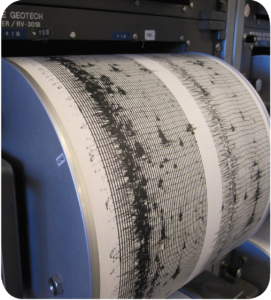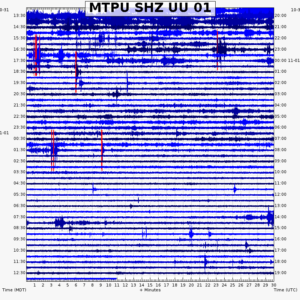The seismograms displayed are from a selected group of seismograph stations routinely recorded by the University of Utah Regional Seismograph Network. Some of the stations displayed are part of the ANSS – Advanced National Seismic System. They simulate (from digital data) the analog “helicorder” seismograms (previous paper-drum recorders), which were historically recorded daily in our earthquake laboratory. These webicorders show a record of ground movement at a particular seismic station over a 24-hour period, and are "read" like a book, from left to right and top to bottom (this is the direction that time increases). As with a book, the right end of any horizontal line “connects” with the left end of the line below it. The times listed along the left side of the webicorder plot, the starting time of the given line, are in local Mountain time, and the times along the right side of the plot, the ending time of the given line, are in Universal, or Greenwich, time. We provide an annotated sample page to assist you in interpreting the seismograms.


When an earthquake occurs, the seismogram will show ground motions that typically last from seconds to minutes, depending on the size of the earthquake and the sensitivity of the seismograph. The height of the recorded waves on the seismogram (wave amplitude) is a greatly magnified representation of the actual ground motion. The magnification is 50,000 times or more depending on the site. A recording of an earthquake has recognizable characteristics. Typically, one can recognize the arrival of different wave types: P (the fastest traveling waves), S (shear waves), and Surface waves.
On these seismograms you may see local earthquakes in the Intermountain West and earthquakes elsewhere in the world. Almost any earthquake in the world having a magnitude greater than 5.5 will be seen in local seismograms. For help in determining where the earthquakes that you are observing are located, check the University of Utah Seismograph Stations recent earthquakes page for earthquakes in Utah and Yellowstone National Park and the National Earthquake Information Center of the USGS for worldwide earthquakes.
For distant earthquakes, be sure to look at one of the stations like HWUT (Hardware Ranch) that has a seismograph that is particularly sensitive to the low-frequency ground motions generated by large, distant earthquakes (see sample). Some types of seismic waves (for example surface waves) from a distant earthquake will only be visible in seismograms from instruments “tuned” to the low-frequency ground motions.
Not all the wiggles seen on the seismograms are due to earthquakes. Anything that produces ground vibrations could be recorded, for example, a car or train that passes by the seismometer (this is why we try to locate most of our seismometers well away from cultural activity).
Sometimes the telemetry link between the field station and the recording lab experiences interference. Such noise is usually easy to distinguish from earthquake-generated signals because the noise is often “spikey” in appearance (see sample).
Other interesting signals may be recorded. For example, we record man-made mining-related blasts (see a station located near an open-pit mine, BMUT), or ground motion induced by high wind conditions (see sample.)
Other resource: USGS An Illustrated Guide to Reading a Seismogram
